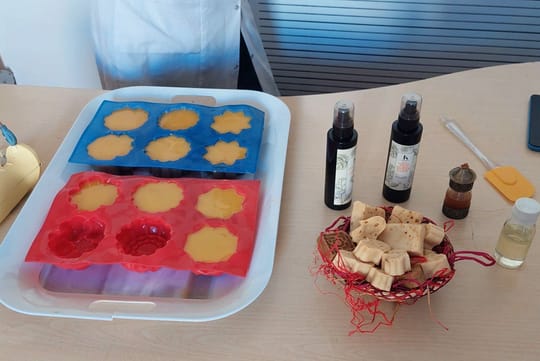Houria Chouhab
F2F Field Officer

Morocco is widely known for its diversity of medicinal and aromatic plants (MAP). Thyme, artemisia, lavender, mentha, geranium, spearmint, and chamomile are the most popular plants that can be found in any Moroccan house, either for medicinal or aromatic purposes.
If you ask me about the best cooperative that provides diverse products based on the use of medicinal and aromatic herbs, I wouldn’t hesitate to mention Tislite Nortane Cooperative. I first met the president of this host organization back in June 2022, during my data collection visits in Demnate municipality in the Azilal province. The visit was followed by two assignments related to the MAP field by the USAID Farmer-to-Farmer Program, implemented by the High Atlas Foundation (HAF) in Morocco.
The first assignment, which took place in November 2022, consisted of a training on manufacturing cosmetics using local medicinal and aromatic plants. As a result of this training, the host organization started making natural soap bars and extracting essential oils. The local expert volunteer, Khadija Barakate, recommended that the cooperative’s members stock the aromatic and medicinal plants for the maceration process that will later be used in the cosmetic products that they are willing to manufacture. Mrs. Barakat also recommended that the cooperative’s members use distilled water in the manufacturing process in order to keep it all natural.
The second assignment took place in December 2022 with the US expert volunteer Laura Shmishkiss, who trained the cooperative’s members on extracting different plants’ vinegar and syrup in order to use in the production of herbal medicines. The volunteer used the local herbs in the training and she highly recommended that the participants practice making the herbal extracts with each other, especially the herbal vinegar and oil products, as well as testing the products first before moving to the commercialization phase.
Tislite Nortane Cooperative consists of five female members, and two additional female members work occasionally when the demand for specific products is high. These members were actively engaged in both workshops and made sure to apply the recommendations to ensure that the cooperative would go forward and present their products in the local markets.
Speaking about herbal products, Lala Neima, the president of Tistlit Nourtane, shared a personal anecdote on the power of these products. She told me that her husband was under the weather a couple of weeks ago and he isn’t a big fan of chemical medicine. She tried different ways to convince him to take his drugs since he has a weakened immune system, and she was worried the flu would affect him further. Eventually, she decided to go for herbal medicine, and she made one of the recipes learned from Laura in the last workshop. Neima said that the next day, her husband started to feel better and he began to recover from the flu quickly. “Laura was right when she said that we need to try it first, and it motivated me to make more of this herbal medicine and share it with people around me,” stated Neima.
The medicinal and aromatic plants sector in Morocco is emerging as one of Morocco’s agricultural products with the greatest potential for growth, and Morocco was already ranked 12th in the world in MAP exports and the organic MAP market was growing significantly every year. MAPs could provide a viable source of sustainable income for farmers, collectors, and many other Moroccans associated with the value chain, most of them in rural communities.
